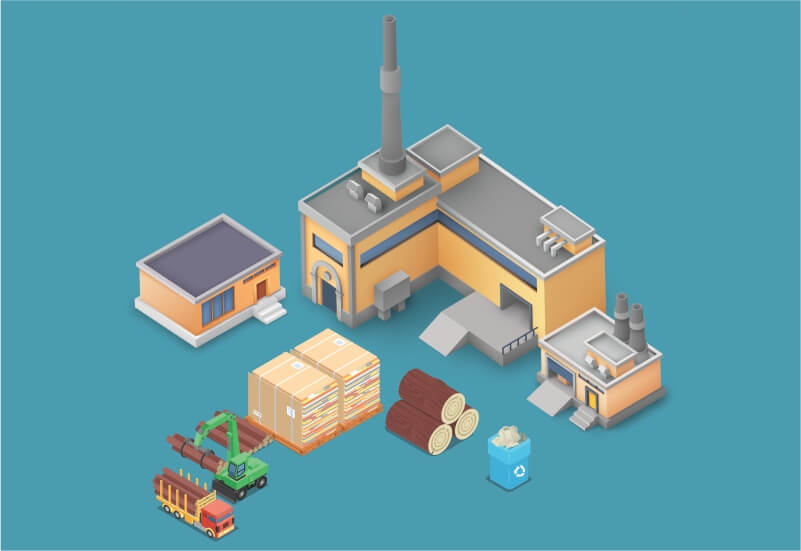
Businesses across various industries including the pulp and paper industry are faced with overwhelming challenges and uncharted waters as they continue to navigate the impacts of the COVID-19 pandemic. Amidst this uncertainty, the steps for reinvention and being resilient are undoubtedly important, but the industry must now consider how the pandemic’s impact should influence their procurement and recovery strategies and approach with respect to raw material management amongst other aspects.
Keeping these challenges in consideration, Paper Mart initiated an editorial feature to gain insights on the strategies adopted by the paper industry for raw material management on a continuous and sustainable basis, the impact of the lockdown causing a huge disruption in the logistic and procurement pipeline, and the major milestones achieved specific to raw material procurement, processing and consumption.
As we look back on the year 2020, it’s impossible to overlook the impact of the global pandemic on countless industries and the economies of almost every nation around the globe. In the face of the COVID-19 crisis, the pulp and paper industry had to swiftly make efforts to optimize their company’s resilience – while assessing opportunities for growth coming out of the downturn.
This brings us to the question: how has the pulp and paper industry felt the impact of COVID-19? Has it bounced back? To mitigate the impact of the crisis – how have the paper making companies strategized to ensure consistency in the raw material management?
Understanding the Impact
All things considered, the Indian paper industry has been under a great deal of stress beginning from March 2020, however, the recovery was seen for a couple of months in the latter part of 2020, after some balancing on trade globally but then we were hit by the second wave of COVID.
Speaking about how the pandemic-resultant lockdown caused a huge disruption in the logistic and procurement pipeline and how this, in turn, has impacted the company, Mr. P K Suri, Director & CEO, The Sirpur Paper Mills Limited affirms: “this had a direct impact on the availability of raw material which created a demand-supply gap and increased the rate of raw material. Even the logistics was severely affected.”
Raw Material Management amidst Crisis
A combination of factors has come together to create a global supply side constraint, leading to an increase in the prices of raw materials in the paper industry. The mills which are dependent on waste paper grades, for making the deinked pulp or for making the recycled grades of packaging boards, were hit the most due to the poor collection of wastepaper globally. Further, there were significant logistics issues as well due to the non-availability of the vessels/containers. This has hiked up the prices of all the grades of waste paper almost double of what it was in the pre-COVID scenario.
“This has put the mills under tremendous stress for realizing the decent contribution for the grades of production and hence, the profitability is hit by at least 15-20%… Most of the paper mills in the country had the capacity utilization of 70-75% in the financial year 2020-21 and the same is in sight this financial year too, with the lockdowns getting announced and extended in various states,” says Mr. SVR Krishnan, Executive Director (Operations), Tamil Nadu Newsprint and Papers Limited.
Outlining the approach for controlling raw material utilization and consumption, Mr. A. K. Bansal, Executive Director, N R Agarwal Industries Ltd. asserts: “with the right planning, raw materials can be managed and optimized at a professional level while reducing overall inventory costs considerably. Keeping an eye on raw materials inventory can provide a significant competitive advantage as well as a cost advantage.”
What’s New? What’s Next?
Mr. Ganesh Bhadti, President Operations at Seshasayee Paper and Boards Limited explains the methodologies their company has adopted to allow for real-time, in-process monitoring and control over raw material procurement. “Inventories are monitored from a day-to-day basis to shift-to-shift basis. The process team and the supply chain team discuss the monthly requirements and plan well in advance the raw material requirements for the production target for the month.”
“The policy of fall-back arrangements, say chemical or raw materials has enabled us to run the system even in this tough situation,” he added.
Emphasizing the importance of automation in their production and day-to-day operations, Mr. Jagdeep Hira, Business Head, Yash Pakka Limited, says “Since the last two years, we have been investing heavily on automation technology just to control the input and we have seen tremendous improvements in the results that are far more consistent than our previous methods of checking output results.”
In fact, real-time data monitoring and in-process control should be implemented in the production processes in addition to raw material procurement process beginning from the assessment of requirement, supply chain strengthening, strict quality checks and waste minimization in storage and transit.
Since the intensity of the challenges the industries have been facing goes beyond the immediate crisis as it is difficult to assess the future impact, it is recommended for the paper industry to adopt a more nuanced approach for raw material management.

The Sirpur Paper Mills Limited
“We are focusing on developing farm forestry plantations in mill catchment. With focused R&D, we have released many clones of pulpable species which are fast-growing, high yielding with excellent fibre properties.”
Impact of the Pandemic on Profitability and Productivity
The pandemic has severely impacted the availability as well as the cost of raw material. The pandemic and the resultant lockdown have reduced the availability of labour involved in the harvesting and wood handling mainly due to the returning of migrated labour from other states. This had a direct impact on the availability of raw material which created a demand-supply gap and increased the rate of raw material. Even the logistics was severely affected due to the reduced availability of truck drivers, reduced availability of trucks, restriction on their movement and arranging e-pass for goods other than essential commodity was a tedious task especially for inter-state movement. This had an adverse effect both on the production as well as profitability.
Approach for Raw Material Procurement, Processing and Consumption
We are focusing on developing farm forestry plantations in mill catchment. With focused R&D, we have released many clones of pulpable species which are fast-growing, high yielding with excellent fibre properties. This has also created a strong pull factor amongst farmers to plant our desired species. By increasing the raw material availability in our catchment, we can develop control over its supply and we can source raw material of our desired qualities.
Methodologies Adopted for Real-Time, In-Process Monitoring and Raw Material Procurement
The adopted methodologies are as under:
- We are continuously working to reduce the Turn Around Time (TAT) for trucks of raw material
- We are using Google forms for tracking of raw materials trucks, so its arrival at the mill and subsequently unloading can be pre-planned
- Apart from Google forms, we have some internal controls to monitor and regulate incoming trucks of raw material. These controls help in efficient wood handling and its consumption
Support Expected from the Government
The government should allot revenue/degraded forest land to wood-based industries for large scale captive plantations for sustainable raw material generation. The government must ensure the unrestricted movement of raw material of mill especially interstate movement. In addition, the government should provide financial assistance to farmers for taking farm forestry plantations, which will also help in increasing green cover. Further, the subsidies/ financial stimulus package should be provided for paper manufacturing units to combat adverse effect of the pandemic. Also, health assistance for unorganized labour and proper vaccination drive for risk group should be organized.

Tamil Nadu Newsprint and Papers Limited
“Our strategy on the raw material-procurement, mainly for the various grades of the pulp and bulk chemicals, is to buy from the reliable and established sources… We work on a 20-30 days inventory schedule by incorporating “Manufacturing Excellence” trigger points under Smart Procurement Teams.”
Impact of the Pandemic on Profitability and Productivity
Yes, there has been a terrible impact due to the pandemic. On the whole, the paper industry has been under great deal of stress right from March, 2020, however, the recovery was seen for a couple of months in the later part of 2020, after some balancing on trade globally but then we were hit by the second wave of COVID. Unfortunately, the pulp and paper mills, whether big or small, have been majorly affected from both the supply as well as the demand.
The mills depending on the waste paper grades, for making the deinked pulp or for making the recycled grades of packaging boards, were hit the most due to the poor collection of wastepaper globally and the logistics issues due to the non-availability of the vessels. This has jacked up the prices of all the grades of waste paper, be it white or grey, pre-consumer or post-consumer, almost to double of what it was in the pre-COVID scenario. Today, the prices of white recycled waste are up to 380 USD per ton and the price of ONP is up to 260 USD per ton. This has put the mills under tremendous stress for realizing the decent contribution for the grades of production and hence, the profitability is hit by at least 15-20%. The mills which are imported HW and SW bleached pulp-dependent were also hit badly as the bleached virgin pulp prices were also on its peak with 60-80% increase in the prices and their profitability is also hit by 10-12%, compared to the larger integrated pulp and paper mills, with their own in-house pulp.
Most of the paper mills in the country had the capacity utilization of 70-75% in the financial year 2020-21 and the same is in sight this financial year too, with the lockdowns getting announced and extended in various states. Nevertheless, with the effort of the government in every state of the country and many vaccine grades available, the situation may be brought under control soon.
Approach for Raw Material Procurement, Processing and Consumption
The procurement of raw material is a quite specific to mill site, and the grades. We, in TNPL, have three paper machines and one coated board machine, using five grades of furnishes such as Euca-based hardwood pulp, imported softwood pulp, chemical bagasse pulp, de-inked pulp and BCTMP grades of pulps, for making various grades of paper and packaging boards.
TNPL does all the procurement through the e-procurement or the reverse auction method leveraging on the huge vendor base and with the best possible price. For some critical inputs, where we cannot have the exposure of the process or the products to all the vendors based on the lower price due to stringent CTQs, we have started the procurement with the limited enquiry basis, to select the best quality vendor at competitive prices.
Our strategy on the raw material-procurement, mainly for the various grades of the pulp and bulk chemicals, is to buy from the reliable and established sources at the best price possible and to keep the narrow inventory period. We work on a 20-30 days inventory schedule by incorporating “Manufacturing Excellence” trigger points under Smart Procurement Teams.
At TNPL, we tap all the government sources in Tamil Nadu and also in the nearby states like Kerala and Karnataka for the government tender sale and also for the collection of the white and mixed waste. We also have a good tie up with all the colleges and universities for the collection of the white waste such as question papers, answer sheets and other office records etc. Our marketing team has a good tie up with the printers and converters for the collection of the printed and unprinted white waste mainly from the southern regions, to take advantage of the freight.
Our strategy will always be to maximize the usage of the minimum cost raw material and the subsequent furnish in the products, ensuring that the final paper or board properties are met. The fibre consumption in each grade is monitored shift-wise by the respective vertical heads, by optimizing on the filler usage, wet-end process chemicals and also by controlling the web breaks on the machines and reducing the quality and converting rejections at each stage of manufacturing.
Methodologies Adopted for Real-Time, In-Process Monitoring and Raw Material Procurement
As already explained, the procurement is through the tendering process with the reverse auction to get the price advantage. We also follow very closely on the price indices published by various agencies and to keep track of the right time to buy the bulk material.
The consumption pattern is meticulously monitored by the senior management team fortnightly and then the corrective actions on procurement or dynamic change in the product mix on each machine will be put in place to manage, without stock out situation at the same time without any major deviations in the final product quality.
For the raw material consumption, be it fibres or process chemicals, we use the process DCS and QCS trends with the best batch/lot back-up analysis along with the statistical methods like control charts, moving range charts and Cp & CpK etc to ensure the adherence to the specification, without overdoing in the process, on the speck limits. This has really helped us to optimize the quality and cost.
Support Expected from the Government
As India is a net fibre import country and the pulpwood plantation cover is lesser compared to the Scandinavian and other European countries, we also fall short with the quality fibres for the wood pulp manufacture. Even the kind of fibre length and fibre strength is much less compared to these countries. Keeping this scenario in mind, the government should aggressively promote forestation policies, making the policy to be industry-friendly, by allowing the paper mills to own the land for raising their pulpwood plantations. This will also improve the green cover in the country alongside making the industry self-sustainable.
Farmers – Paper mills – Timber Traders can be formed as a triangular rural economy model and the livelihood of the society can be enhanced further. Similarly, there can be a Super Social Forestry Model.
Government agricultural universities in various states can be engaged for the best species suited to the local conditions, helping the farmers to grow the high yielding varieties for better income and to fulfill the requirement of the local paper mills. These universities can also help the farmers with the soil quality tags, for the suitable fertilizers at the right quantity and also for the consumption of the local mill-treated effluent water, by way of drip irrigation. The entire cycle of activities can be performed as a circular economy model.
Now, the government has to seriously consider the rural economy model by bringing the local pulp and paper mills, the local Farmers (having more than 50 acres of land) and the educational machinery (better schools and colleges) by pooling good IITs and AU graduates to the rural side of the country’s economy. There is a lot more to do here for the maximum and sustainable returns.

Naini Group of Industries
“Our long-established relationship with our suppliers has also enabled us in maintaining our inward supply of raw material and fuel.”
Impact of Pandemic on Profitability and Productivity
Due to the disruption in logistic chain with the imposition of the lockdown, the supply of inputs (excluding raw material and fuel) has been badly affected. The prices have also gone up owing to the disruption in transportation and scarcity of trucks. Additionally, the shortage of manpower has also been a reason for this disruption. Needless to mention, the productivity and profitability have both been adversely affected. This is going to have a ruining impact on the annual results of the company as well.
Approach for Raw Material Procurement, Processing and Consumption
For agro-based mills, the impact of the pandemic has not been much, as the raw material is already procured in a seasonal manner. In our case, we already had sufficient storage of bagasse and fuel (rice husk). Thus, the supply chain with sugar mills was uninterrupted. Also, since the production was reduced due to the slump in the market demand, the raw material shortage has not been a major issue for us.
Methodologies Adopted for Real-Time, In-Process Monitoring and Raw Material Procurement
We strive to maintain the supply chain on a regular basis with a steady supply of bagasse to the sugar mills and of rice husk to the rice mills. Our long-established relationship with our suppliers has also enabled us in maintaining our inward supply of raw material and fuel.

Seshasayee Paper and Boards Limited
“Pandemic took a big toll on the business. Life beyond the Covid-19 pandemic holds much promise provided we are ready for transformation.”
“Inventories are monitored from a day-to-day basis to shift-to-shift basis. The process team and the supply chain team discuss the monthly requirements and plan well in advance the raw material requirements for the production target for the month.”
Impact of the Pandemic on Profitability and Productivity
The nationwide lockdown to curb the COVID-19 pandemic has impacted the demand for paper and paper boards which is likely to witness a 10-15 percent year-on-year decline in FY 2020-21. The demand has shrunk as schools and colleges are shut down, while the majority of offices have also crimped demand for writing & printing paper. Furthermore, the usage of industrial paper has also crumpled because of weakness in FMCG, consumer durables and apparel and apparel segments, which account for around 50-60 percent of the demand. The demand for paper and boards is expected to contract 10-15 percent this financial year as compared to the previous year. About 40-45 percent of paper mills are in the COVID-19 red zones, and another 40-45 per cent is in orange zones.
In addition to this, the industry is also grappling with the shortage of raw materials which is ultimately affecting the capacity utilization. Besides, exports have also fallen. However, the export market is still in a better situation than the domestic market. But export prices are unremunerated. Because of container and freight issues, we are under pressure to reduce ex mill price. This will affect the financials of the paper makers, especially the small and mid-sized ones, which are highly fragmented. The outlook has been revised from ‘positive’ to ‘stable’ on the account of lower-than-expected improvement in the profitability and the production efficiency primarily due to the COVID-19 led business disruption and due to the weak demand for writing & printing paper and newsprint and lower capacity utilization.
The pandemic has caused disruption in the materials movement of both the indigenous as well as the imported goods. The paper mills across the country have received special permission for functioning as they are classified under continuous process industry in essential categories. Although some of the paper mills have operated completely, their sales percentage as well as the corresponding profit has suffered a huge drop.
Imported Goods movements:
There has been a significant delay in the arrival of import consignment due to the non-availability of containers. Moreover, due to the non-availability and the huge demand of Chinese market, there has been a scarcity in the material availability. Hence, the prices have increased, but we have maintained long term contract prices wherever it is possible.
Indigenous movements:
The indigenous goods have suffered issues in interstate movement due to the restrictions resulting from the pandemic situation. However, with the special permission obtained from the government of Tamil Nadu, all the process materials’ movements between the interstate became possible. The paper mills have issued the special declaration letter stating that the material is being transported to a continuous process industry exempted from the lockdown. Also, combining smaller consignment loads into bulk loads wherever possible has facilitated the logistic movement seamlessly by collecting from multiple points.
Profitability & Productivity:
Some of the Indian paper mills have halted production at their units due to the pandemic. But a few paper mills which had operated completely have suffered issues in selling the finished goods. Also, some of the paper mills have stocked the finished products optimistically in view of successful sales after the pandemic period or for their own use during emergencies.
Due to the pandemic-resultant lockdown, the consumption of our products has drastically come down which has affected our business via increasing inventory, low production, low sales etc. All the input chemicals costs have gone up steeply which has eventually impacted our profitability.
Approach for Raw Material Procurement, Processing and Consumption
Wood:
The strategy adopted by the paper industry to meet its ever-growing demand of wood on a continuous and sustainable basis is by expanding the social and farm forestry plantations apart from raising plantations by forest development corporations.
Some of the strategies adopted include – the close monitoring of yield, ensuring remunerative price for farmers, trying to make payment on time and to look for a combination of pulp including DIP instead of depending only on wood and trying to maximize ash in paper.
The daily stock report of major raw materials has been taken up and analyzed to ensure the stock level is maintained with the min buffer level. Also, we ensure that the process department utilizes the raw material eventually as per the production requirements.
Our main raw material is wood which we procure majorly from Tamil Nadu particularly from the farmers. During the lockdown, there was a restriction on cutting and labour movement from one place to another due to which we weren’t able to arrange required quantities in time. Since the trucks were allowed to bring the materials, the logistics was not an issue this time. Normally, we used to maintain our raw materials stock as inventory for one month and we haven’t faced any shortage of wood.
Chemicals:
We look for alternate suppliers, procuring more indigenous items at competitive quality and cost. With our in-house R&D team, trials were undertaken and the cost impact analysis was also made to work with different ratio of wood species in cooking. Trial of bleaching chemicals with and without some of the chemicals is taken to assess the impact on the properties of pulp, improving the chemical recovery cycle to bring down waste in our processing.
Other secondary input materials like sodium chlorate, oxygen, sulphuric acid, starch, calcium carbonate, etc also became critical owing to the pandemic and their costs have gone up to a very high level which has increased our cost of production. Some alternate chemicals or process changes are helping us to recover losses to some extent.
Other major milestones in the procurement, processing and consumption in the company are:
- Coal procurement from the stock and sale party due to the demand in Indonesian market
- Non-availability of liquid oxygen on account of the pandemic. Hence, we have made alternate arrangements in the process for utilization of hydrogen peroxide in place of liquid oxygen
- Rate reduction in the procurement of hydrogen peroxide, caustic lye etc.
- AMC orders value – Rate reduction
New Vendor Development for sizing chemicals and GCC has also helped in cost reduction and alternate source of supply.
Methodologies Adopted for Real-Time, In-Process Monitoring and Raw Material Procurement
Inventories are monitored from a day-to-day basis to shift-to-shift basis. The process team and the supply chain team discuss the monthly requirements and plan well in advance the raw material requirements for the production target for the month.
The chemical consumption is monitored online both on their as such-basis and per-ton-basis. The policy of fall-back arrangements, say chemical or raw materials has enabled us to run the system even in this tough situation.
- The stock statements taken from the system (ERP) provide real time monitoring of the daily consumption and accordingly sourcing of raw materials is being planned
- Stocking advised items requirements are automatically generated from the ERP system based on the consumption from the user department. The system will not allow for the nil stocking, as it necessitates pre-ordering the item which is below the minimum stock level
- During this COVID-19 pandemic, we have switched over to plasma cutting and welding in place of the oxygen gas-based welding process
In chemical and additives procurement, the cost has gone up due to the increase in freight charges along with the basic price of the materials. Particularly, the movement of all the imported items had to be stopped due to their higher logistics costs (including the pulp and calcium carbonate filler). Secondly, the import of oxygen which is one of the important eco-friendly bleaching agents was stopped for medical reasons. Thus, we had to go ahead with an alternate costly bleaching chemical called hydrogen peroxide which has also increased our overall cost of production.
Support Expected from the Government
Financial assistance (credit) for the procurement of raw material is for up to 120 days. Materials facilitated under bulk supply arrangements are provided at bulk supplier’s rate by eliminating the middlemen and thus, the goods are procured at a lower price. The discounts received under bulk supply arrangements are shared with MSMEs, enabling them to reduce the cost of purchase of materials (Economies of Scale). The availability of raw material on credit and enabling the MSMEs to execute the orders in hand would greatly benefit the paper industry. The MSMEs operations can be started pertaining to them being in the category of the continuous process industry.
The government can support the paper industry with regard to the challenges pertaining to the raw materials in the following ways:
- Intimation to all customs authorities across sea ports for relaxation in clearing the import consignments
- Ensuring nil demurrage charges for all import consignments and a common notification to ensure avoiding demurrage
- In order to avoid economic losses, the government should support the industries by allowing them to operate with some constant conditions. The major one is the stabilization of fuel prices, which is really affecting the industries while fixing the procurement costs. This situation can be controlled by the government.

Satia Industries Limited
“Our approach has always been to focus on procuring maximum raw material locally, and maintaining a strong relationship based on trust and loyalty with our vendors in addition to a strict vigil on the quality-related parameters…”
Impact of the Pandemic on Profitability and Productivity
The pandemic-resultant lockdown and the subsequent issues in logistics had very limited effect on our raw material procurement except with regard to sourcing wood chips and veneer waste that we procure partially from Haryana. Since we are positioned in the heart of the wheat belt, we had no issues in the procurement of wheat straw within a radius of 30-40 km which fulfils our daily requirement. Similarly, our fuel is also sourced locally and a slowdown in industrial activity led to heavy reduction in rice husk prices in this period. However, our wood chips and veneer waste prices had moved higher due to the shutdown of the plywood industry and the movement of migrant labour back to their native places.
The paper industry especially the mills which are waste paper-based and those dependent on the imported wood pulp were totally shaken by the poor availability of both indigenous and imported raw material despite the steep hike in prices and logistic-costs coupled with poor demand and fall in prices.
Approach for Raw Material Procurement, Processing and Consumption
Our approach has always been to focus on procuring maximum raw material locally, and maintaining a strong relationship based on trust and loyalty with our vendors in addition to a strict vigil on the quality-related parameters, scientific storage to slowdown decay and optimizing storage capacity. This has helped in reducing our cost and avoiding any raw material crisis for many years. Flexibility in seasonal procurement and consumption of raw material is maintained by utilizing wheat straw, sarkanda, kahi, bagasse, bamboo etc.
Methodologies Adopted for Real-Time, In-Process Monitoring and Raw Material Procurement
Real-time data monitoring and in-process control is implemented in the production processes but not much in raw material procurement process which starts from need analysis, supply chain strengthening, contracts in writing, strict quality checks on the spot for moisture, stacking and waste minimization in storage and transit.
During the consumption, metered supply is ensured to avoid wastages, reuse of system spills and rejects wherever possible, and the controlled dosing of chemicals, maintaining processing conditions and timing are controlled using the latest technology. These processes are implemented to get optimum yield, low waste and to attain near to ideal consumption.
Support Expected from the Government
The government must allow the use of degraded land for agro-forestry and encourage and educate the farmers not to burn straw in their fields. It would be favorable to incentivize the straw collection, support the storage activity and provide tools and tackles at low interest rates.
Further, the government should also encourage the paper industry to utilize agro waste, veneer waste and promote agro-forestry which would result in pumping money into the farm sector and help in generating large-scale employment which would be a propitious strategy for our economy.

N R Agarwal Industries Limited
“With the right planning, raw materials can be managed and optimized at a professional level while reducing overall inventory costs considerably…. With regard to the processing and the consumption of raw material, there is more attention given on the process optimization and ensuring to achieve almost nil to minimum fibre loss.”
Impact of the Pandemic on Profitability and Productivity
The COVID-19 virus has not only taken the lives of people but has also severely crippled the economy and serval industries including the paper industry.
Due to the pandemic situation and further because of the outbreak of the ongoing second wave since March 2021, both the inward and outward supply chain of the paper industry have been totally disrupted, which had somehow started gaining its pace when the COVID-19 cases were almost dropped to a minimum. However, presently, due to the strict lockdown, the manufacturing and logistics activities have been suspended, and it has affected the demand and supply of various products as a result of restrictions imposed on shopkeepers and retailers. The demand had badly dropped due to the lockdowns imposed by almost all the states resulting into the closing down of educational institutions, commercial establishments and downstream printers, publishers, converters, and stationery which has resulted in to reduction of the production and some cases even closing down the industries. Because of this the profitability of the mills has come down drastically. Among various business segments within the paper industry, the packaging industry has fairly done better across segments like pharma sector, FMCG and growth of the e-commerce business. However, the education, office and commercial segments have been adversely affected.
Approach for Raw Material Procurement, Processing and Consumption
For controlling raw material utilization and consumption, we are keeping track of raw materials inventory. As a critical part of a delicately balanced ecosystem, managing raw materials inventory can make or break the supply chain effort. As the material plan and purchasing coordinate to deliver raw materials, there are several other issues which need to manage tightly. With the right planning, raw materials can be managed and optimized at a professional level while reducing overall inventory costs considerably.
Keeping an eye on raw materials inventory can provide a significant competitive advantage as well as a cost advantage for most companies. With the challenges faced by the small and medium companies as globally sourced supply chains continue to become more complex, data-driven, analytically capable software are the best option for managing raw materials inventory without losing track.
With regard to the processing and the consumption of raw material, there is more attention given on the process optimization and ensuring to achieve almost nil to minimum fibre loss. To achieve the goal, we have installed some fibre saving equipment such as reject sorters and drum screens etc. Also, on the other hand, we are compelled to use more percentage of imported waste paper as the availability of local waste paper is very much reduced because of the lock down imposed by most of the states.
Methodologies Adopted for Real-Time, In-Process Monitoring and Raw Material Procurement
Raw material management is critical to the overall performance of any manufacturing unit. Besides the demand and other forces like competitor’s actions and the general price index; raw material situation in terms of efficient management and effective planning determines the activity level, the turn-over and the ultimate profit in any company. Material management being based on the coordination of efforts (planning, controlling, organizing, directing), thus, achieving efficiency in the procurement, transportation, stocking and utilization of inputs of our manufacturing organization is central to production activities and management. We feel that effective and efficient functioning of the material management has direct bearing on the total performance of the organization. Thus, the management of raw material in our organization is given attention and critical study in order to achieve uninterrupted production runs and enhanced performance in operations.
These objectives are achieved through integrated approach to material management functions by combining planning, procurement and inventory control. Another important issue in material management is the matter of maintaining good systems and procedures and this calls for strict discipline in documentation. This implies that all related paper work are completed in time so as to generate the basic data and compile timely and reliable information for planning, follow-up and control.
Support Expected from the Government
India, the largest overseas market for the U.S. mixed paper, has tightened the quality standards and reduced its recycled fibre import volume. Imported mixed paper is now allowed with a maximum of 1% contamination. The move threatens to close a major outlet for the U.S. mixed paper: from January through November 2019, the most recent month for which figures are available, India imported 1 million short tonnes of mixed paper from the U.S., or 41% of all the U.S. mixed paper exports. The next closest country in terms of import volume was Canada, bringing in 253,000 short tonnes of the U.S. mixed paper during the first 11 months of 2019. India is already a fibre deficit country and mostly depends on recycling waste paper, hence, to make sufficient raw material available for the paper industry, the government should announce some relaxations. On the other hand, the imports of paper and paperboards, excluding newsprint into the country, have been increasing steadily. In the last nine years, imports have risen at a CAGR of 11.34 per cent and in value terms from INR 3,411 crore in 2010-11 to INR 8,972 crore in 2019-20. If the imports are growing at the same high rate, then the industry sometimes underutilize the domestic installed capacity, which hits the paper industry economically. The government can look into this issue also.
The paper industry is hoping that the Covid-19 pandemic second wave disappear and paper business gets back to normalcy with schools, educational institutions, commercial establishments start functioning normally.

Yash Pakka Limited
“Since the last two years, we have been investing heavily on automation technology… we have seen tremendous improvements in the results that are far more consistent than our previous methods… the change in focused approach have resulted in cost reduction and consistent quality.”
Impact of the Pandemic on Profitability and Productivity
This is an unfortunate period for all the businesses across the world; especially the impact of the second wave has been severe in the country. As far as the paper industry is concerned, unfortunately the timing of the second wave of pandemic has critically impacted the operations of the paper mills. Specifically, with education sessions going online and the states announcing partial intermediate lockdowns have impacted the writing & printing industries, forcing some to curtail the production and build up stocks inventory. This period across the year has historically been the up time for industry and the closer of aforesaid institutions and the states is definitely an opportunity lost beyond recovery.
Similarly, the lockdown has impacted the kraft paper industry with the closure of physical shopping, restaurants chains and many converting industries being shut in various states that have caused a reverse impact on the paper industry and the demand going slow to almost nil. Overall, since March 2020, barring 2-3 months where industry had witnessed an upturn have again slowed down and has faced even the closing of production lines due to no demand.
Approach for Raw Material Procurement, Processing and Consumption
Though as stated earlier, it has been an unfortunate time but it has given various opportunities to step back and think on the cost reduction-front to overside the huge losses the companies have seen in the previous FY. Our team has worked exceptionally hard on optimizing the input cost by efficiency-improvements and has taken steps for reducing the procurement cost as well. On the procurement-front, we have entered into yearly contracts with the raw material suppliers with equal commercial proposition with the vendors. Sustainable practices have been implemented in the waste reduction at all fronts. Further, the strengthening of SOP and setting up automation wherever the need was felt to control losses were implemented.
Methodologies Adopted for Real-Time, In-Process Monitoring and Raw Material Procurement
We have always believed in controlling the input at every stage and consequently, when the inputs are controlled, the resultant shall be even in any case with the support of well-engineered equipment.
Since the last two years, we have been investing heavily on automation technology just to control the input and we have seen tremendous improvements in the results that are far more consistent than our previous methods of checking output results. Thus, the change in focused approach has resulted in cost reduction and consistent quality.
Every process across the operations at the company has the online real-time monitoring mechanism. We have implemented the process to be controlled by automation and the team members should control the automation.
Support Expected from the Government
As of yet, as an individual entity and as the member of IPMA, we have been pursuing the government to extend various kinds of support to the paper industry, however, it has been disheartening that the movement has been quite slow. As we have seen during the pandemic, many papermaking companies struggled to continue operations, we had expected the government to initiate some pertinent policies of putting some import duties on paper imports and especially, as a nation, we want to promote the ‘Make in India’ initiative. Similarly, the import duties on input raw material should have been waived off at least during these critical times to sustain and support the paper industry.
Moreover, the paper industry has seen ground water charges implementation during the same period and the emission norms getting implemented as well — despite most of the paper mills like us operate on bio fuel and support farmers on their earning and contribute in reducing pollution load.
Government has to really see and implement successful Make in India concept where the industries in India, including the paper industry in holistic view rather than ministries/portfolio acting independently.

Kuantum Papers Limited
“We have built the ‘Procurement Analytics Function’ which gives us very strong ‘Control Tower Type capabilities’. Backed by real-time data from SAP, insightful information dashboards are created… The procurement team, backed by this information, regularly reviews market situations, potential emerging scenarios and creates action plans to address these scenarios.”
Impact of the Pandemic on Profitability and Productivity
The second wave of COVID -19 was intense and has impacted the lives and livelihood of people, but for a limited duration. Thankfully, we are seeing a continuous reduction in cases from May and June. We pray and expect everyone to bounce back faster and stronger. The states are rapidly opening up various sectors and key markets. The varied lockdown/restriction protocols followed across different states during the second wave has resulted in some new challenges.
Due to this situation, the interstate procurement and movement of raw material was affected. The procurement activities were largely restricted within the bounds of state sources, which resulted in demand and supply imbalances, leading to price escalations. From a finished goods-perspective, the domestic demand was muted in April and May as schools, colleges and offices remained mostly shut. However, we believe the industry as a whole was a little better prepared this time as compared to last year’s first wave. The negative impact of the crisis in the domestic market was set off to some extent by shifting quickly to exports and the government orders. The paper mills may have experienced some inventory build-up in these months. However, with off takes in exports and the government orders, this effect started getting diluted. We expect to see a recovery in demand from the end of second quarter onwards.
In a nutshell, even though the second wave was intense, its effect was largely brief. The Indian paper industry was better prepared on account of the learning curve obtained from the first wave, which resulted in a lessening of the negative impact this time around.
Approach for Raw Material Procurement, Processing and Consumption
The first phase of COVID-19 last year was long drawn and had a global impact. The pandemic and the ensuing uncertainties last year made us realign our procurement strategy. Earlier, we used to broadly operate with the concept of “Just in Time” Inventory. However, last year, we made a subtle shift in our strategy and looked at options of creating stocks for specific raw materials when their availability had an improved status and the prices were favourable. We also ensured that our consumption patterns did not lead to an ageing inventory. We have amplified our focus in educating our vendors in terms of meeting defined quality parameters. A better quality of raw material helps to further improve yields, thus reducing the overall consumption of inputs per ton of paper.
We have enhanced our efforts to broad-base our vendors. Recently, when the second wave hit us all, the logistics movement and availability of material was impacted for some time. However, through the shift in strategy adopted last year, we were able to ride out the second wave more comfortably by consuming from our available stocks as and when raw material supply was uncertain. We will continue to invest in further building on this strategic shift with more tactical interventions to improve our bottom line.
Methodologies Adopted for Real-Time, In-Process Monitoring and Raw Material Procurement
We are adopting a broad-based approach to create real-time visibility across the gamut of our operations. We have built the ‘Procurement Analytics Function’ which gives us very strong ‘Control Tower Type capabilities’. Backed by real-time data from SAP, insightful information dashboards are created for each level in the procurement function on a daily/weekly basis. This is complemented with real-time information flow on material received, in transit and planned for the next day. The procurement team, backed by this information, regularly reviews market situations, potential emerging scenarios and creates action plans to address these scenarios. This analytics capability has leapfrogged our ability to stay nimble and proactive. We are able to make quick adjustments to our approach of ‘On the Go’ on a regular basis. Our ability to forecast various situations emerging due to a volatile market has improved dramatically, ever since we have created this in-house capability.
Support Expected from the Government
While we all hope the situation will rapidly improve from the second wave of the pandemic, everyone is already wary of an impending third wave. As a company, we are broadly upbeat about the future.
There are three key areas where we would request the government’s support and intervention. Firstly, we would like to see a far more coordinated “Center–State” approach in the future to manage situations arising out of these pandemic waves. Such coordination should help create uniform policies across neighbouring states specifically in terms of lockdown protocols. These will ease life for the industry as well as the common man, specifically from the perspective of seamless movement of goods while ensuring that the right level of safeguards are in place.
Secondly, we request the government to reconsider its decision of discontinuation of Fuel Supply Agreement (FSA) by Coal India for the non-power sector. The uncertain future due to the pandemic, further compounded with limited transportation options, has resulted in an increased landed cost of coal for industries like ours. Discontinuation of FSA does not change the source of coal but introduces more intermediaries, thus increasing the overall cost of procurement. We urge the government to allow extension of existing FSA’s by at least two years in order to give the industry more time to manage its supply chains in the future.
Lastly, a continuous push towards recent policies that were enacted to reduce stubble (agri-residue) burning to reduce air pollution, needs to be done both at Centre and the State-level. This stubble can be used as an alternate fuel in various industries with capability of multi-fuel boilers and an industry like ours for paper making. If this can be pushed structurally through policy intervention, it will increase the availability of alternate fuel and also help reduce the overall carbon footprints.



